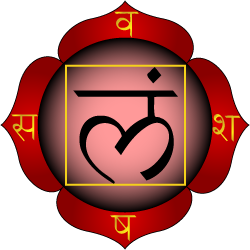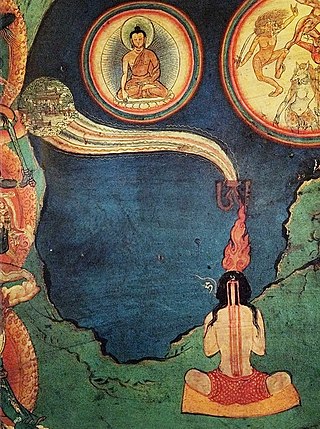
Chakras are various focal points used in a variety of ancient meditation practices, collectively denominated as Tantra, or the esoteric or inner traditions of Hinduism and Buddhism.

In Hinduism, Kundalini is a form of divine feminine energy believed to be located at the base of the spine, in the muladhara. It is an important concept in Śhaiva Tantra, where it is believed to be a force or power associated with the divine feminine or the formless aspect of the Goddess. This energy in the body, when cultivated and awakened through tantric practice, is believed to lead to spiritual liberation. Kuṇḍalinī is associated with Parvati or Adi Parashakti, the supreme being in Shaktism; and with the goddesses Bhairavi and Kubjika. The term, along with practices associated with it, was adopted into Hatha yoga in the 9th century. It has since then been adopted into other forms of Hinduism as well as modern spirituality and New age thought.

Yoga is a group of physical, mental, and spiritual practices or disciplines which originated in ancient India and aim to control (yoke) and still the mind, recognizing a detached witness-consciousness untouched by the mind (Chitta) and mundane suffering (Duḥkha). There is a wide variety of schools of yoga, practices, and goals in Hinduism, Buddhism, and Jainism, and traditional and modern yoga is practiced worldwide.

Kundalini yoga derives from kundalini, defined in tantra as energy that lies within the body, frequently at the navel or the base of the spine. In normative tantric systems, kundalini is considered to be dormant until it is activated and channeled upward through the central channel in a process of spiritual perfection. Other schools, such as Kashmir Shaivism, teach that there are multiple kundalini energies in different parts of the body which are active and do not require awakening. Kundalini is believed by adherents to be power associated with the divine feminine, Shakti. Kundalini yoga as a school of yoga is influenced by Shaktism and Tantra schools of Hinduism. It derives its name through a focus on awakening kundalini energy through regular practice of mantra, tantra, yantra, yoga, laya, haṭha, meditation, or even spontaneously (sahaja).
In yoga, Ayurveda and Indian martial arts, prana permeates reality on all levels including inanimate objects. In Hindu literature, prāṇa is sometimes described as originating from the Sun and connecting the elements.

A subtle body is a "quasi material" aspect of the human body, being neither solely physical nor solely spiritual, according to various esoteric, occult, and mystical teachings. This contrasts with the mind–body dualism that has dominated Western thought. The subtle body is important in the Taoism of China and Dharmic religions such as Hinduism, Buddhism, and Jainism, mainly in the branches which focus on tantra and yoga, where it is known as the Sūkṣma-śarīra. However, while mostly associated with Asian cultures, non-dualistic approaches to the mind and body are found in many parts of the world.

Muladhara or the root chakra is one of the seven primary chakras according to Hindu tantrism. It is symbolized by a lotus with four petals and the colour pink or red.

Kālacakra is a polysemic term in Vajrayana Buddhism that means "wheel of time" or "time cycles". "Kālacakra" is also the name of a series of Buddhist texts and a major practice lineage in Indian Buddhism and Tibetan Buddhism. The tantra is considered to belong to the unexcelled yoga (anuttara-yoga) class.

Nāḍī is a term for the channels through which, in traditional Indian medicine and spiritual theory, the energies such as prana of the physical body, the subtle body and the causal body are said to flow. Within this philosophical framework, the nadis are said to connect at special points of intensity, the chakras. All nadis are said to originate from one of two centres; the heart and the kanda, the latter being an egg-shaped bulb in the pelvic area, just below the navel. The three principal nadis run from the base of the spine to the head, and are the ida on the left, the sushumna in the centre, and the pingala on the right. Ultimately the goal is to unblock these nadis to bring liberation.

Kashmir Shaivism or Trika Shaivism, is a nondualist Hindu tradition of Shaiva-Shakta Tantra which originated in Kashmir sometime after 850 CE. Since this tradition originated in Kashmir it is often called "Kashmiri Shaivism". It later went on to become a pan-Indian movement termed "Trika" by its great exegete, Abhinavagupta, and particularly flourished in Odisha and Maharashtra. Defining features of the Trika tradition are its idealistic and monistic Pratyabhijna ("Recognition") philosophical system, propounded by Utpaladeva and Abhinavagupta, and the centrality of the three goddesses Parā, Parāparā, and Aparā.

In Tibetan Buddhism, tummo is the fierce goddess of heat and passion. Tummo is found in the Mahasiddha Krishnacarya and the Hevajra Tantra texts.

The Six Dharmas of Nāropa, are a set of advanced Tibetan Buddhist tantric practices compiled by the Indian mahasiddhas Tilopa and Nāropa and passed on to the Tibetan translator-yogi Marpa Lotsawa.

Jain meditation (dhyāna) has been the central practice of spirituality in Jainism along with the Three Jewels. Jainism holds that emancipation can only be achieved through meditation or Shukla Dhyana. According to Sagarmal Jain, it aims to reach and remain in a state of "pure-self awareness or knowership." Meditation is also seen as realizing the self, taking the soul to complete freedom, beyond any craving, aversion and/or attachment. The practitioner strives to be just a knower-seer (Gyata-Drashta). Jain meditation can be broadly categorized to the auspicious and inauspicious. The 20th century saw the development and spread of new modernist forms of Jain Dhyana, mainly by monks and laypersons of Śvētāmbara Jainism.
The Yoga Yajnavalkya is a classical Hindu yoga text in the Sanskrit language. The text is written in the form of a male-female dialogue between the sage Yajnavalkya and Gargi. The text consists of 12 chapters and contains 504 verses.

The fundamental practice of Vajrayana and Tibetan tantra is deity yoga (devatayoga), meditation on a chosen deity or "cherished divinity", which involves the recitation of mantras, prayers and visualization of the deity, the associated mandala of the deity's Buddha field, along with consorts and attendant Buddhas and bodhisattvas. According to the Tibetan scholar Tsongkhapa, deity yoga is what separates Tantra from Sutra practice.
Nāda yoga (नादयोग) is an ancient Indian metaphysical system. It is equally a philosophical system, a medicine, and a form of yoga. The system's theoretical and practical aspects are based on the premise that the entire cosmos and all that exists in the cosmos, including human beings, consists of vibrations, called nāda. This concept holds that it is the energy of vibrations that make up the particles and matter which form the building blocks of the cosmos.
Drishti, or focused gaze, is a means for developing concentrated intention. It relates to the fifth limb of yoga, pratyahara, concerning sense withdrawal, as well as the sixth limb, dharana, relating to concentration.

The Yoga-kundalini Upanishad, also called Yogakundali Upanishad, is a minor Upanishad of Hinduism. The Sanskrit text is one of the 20 Yoga Upanishads and is one of 32 Upanishads attached to the Krishna Yajurveda. In the Muktika canon, narrated by Rama to Hanuman, it is listed at number 86 in the anthology of 108 Upanishads.

Ashtanga yoga is Patanjali's classification of classical yoga, as set out in his Yoga Sutras. He defined the eight limbs as yamas (abstinences), niyama (observances), asana (posture), pranayama (breathing), pratyahara (withdrawal), dharana (concentration), dhyana (meditation) and samadhi (absorption).

Tsalung are special yogic exercises. The exercises are used in the Bon tradition and the four main schools of Tibetan Buddhism. Trul khor employs the tsa lung and they constitute the internal yantra or sacred architecture of this yoga's Sanskrit name, yantra yoga. Tsa lung are also employed in completion stage practices.














